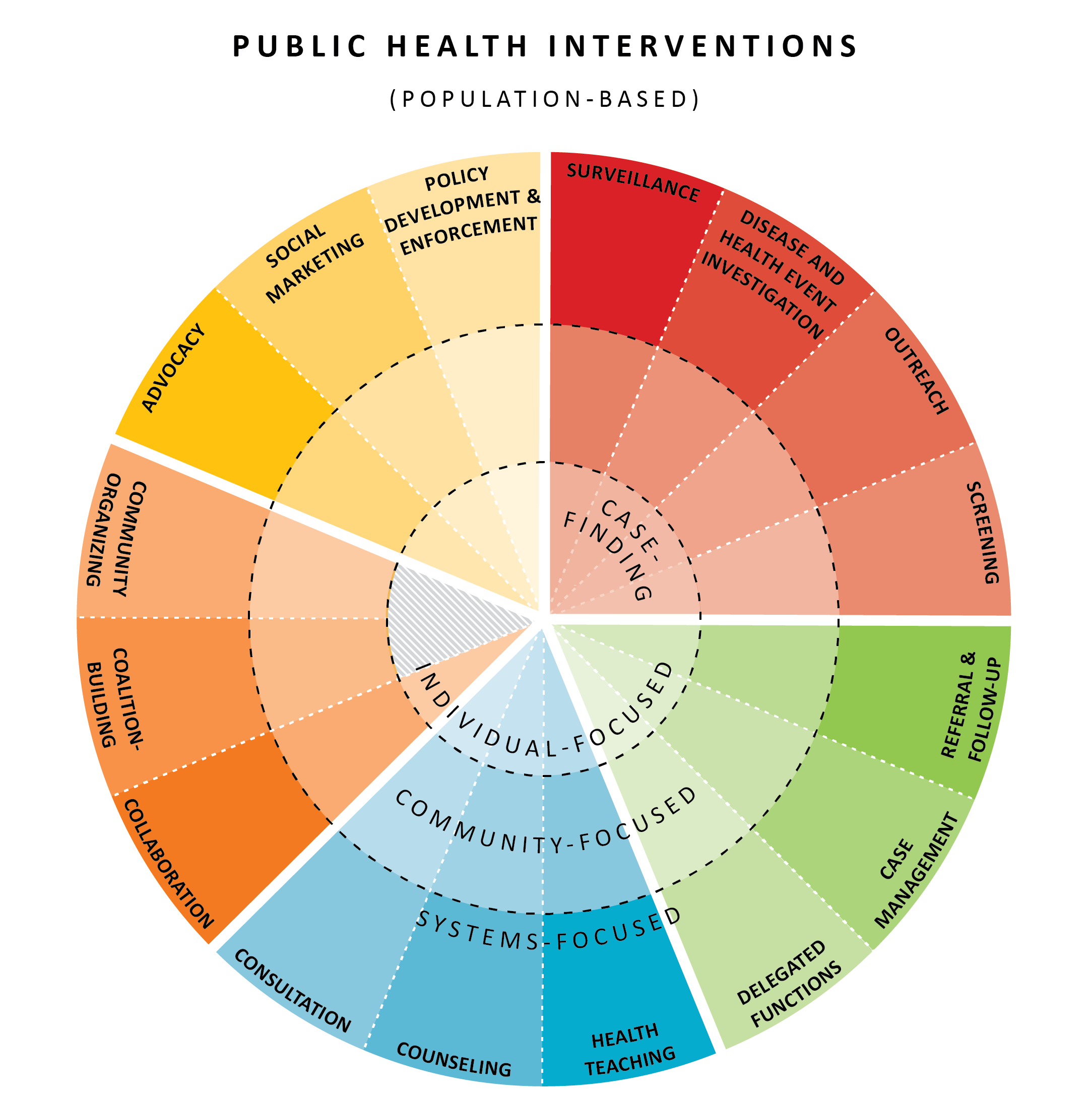Public Health Interventions: Applications for Nursing Practice, 2nd ed. ("The Wheel Manual")
 Public health nurses work in or out of schools, homes, clinics, jails, shelters, mobile vans, and dog sleds. They work with communities, the individuals and families that compose communities, and the systems that affect the health of those communities. Regardless of where or with whom they work, all PHNs use a core set of interventions to accomplish their goals.
Public health nurses work in or out of schools, homes, clinics, jails, shelters, mobile vans, and dog sleds. They work with communities, the individuals and families that compose communities, and the systems that affect the health of those communities. Regardless of where or with whom they work, all PHNs use a core set of interventions to accomplish their goals.
Interventions are actions that public health nurses take on behalf of individuals/families, communities, and systems, to improve or protect health status.
This framework, known as the Intervention Wheel, defines the scope of public health nursing practice by type of intervention and level of practice (individual/family, community, or systems), rather than by the site of service such as home, school, occupational health, clinic, and others. The Intervention Wheel describes the scope of practice by what is similar across settings and describes the practice of public health nursing at the individual/family, community, or systems level. The Intervention Wheel answers the question, “What do public health nurses do?” and delineates public health nursing as a specialty practice of nursing. These interventions are not exclusive to public health nursing, as they are also used by other public health disciplines, except for delegated functions.
Get your copy
Download the full manual: Public health interventions: Applications for nursing practice (2nd ed.) (PDF)
Download a handout on the interventions: Public health interventions, definitions, and practice levels (PDF)
Order a copy of the full manual ($38/ea): Order form (PDF)
Webinar: About this update
November 2020
Public Health Wheel: Intervention update (30:29)
Presenters review new and unchanged content in Public health interventions: Applications for nursing practice, 2nd ed. ("The Wheel Manual"). You also can apply Wheel interventions to considering how PHNs respond to the COVID-19 pandemic.
Suggested citation
Minnesota Department of Health. (2019). Public health interventions: Applications for public health nursing practice (2nd ed.).
Citations
The following publications address use of the Intervention Wheel or a specific wheel intervention to guide practice, research, or nursing education.
Anderson, L. J. W., Schaffer, M. A., Hiltz, C., O’Leary, S. A., Luehr, R. E., & Yoney, E. L. (2018). Public health interventions: School nurse practice stories. The Journal of School Nursing, 34(3), 192-202. doi:10.1177/1059840517721951
Baisch, M. J. (2012). A systematic method to document population-level nursing interventions in an electronic health system. Public Health Nursing, 29(4), 352-360. doi:10.1111/j.1525-1446.2012.01008.x
Bigbee, J.L & Issel, L. M. (2012). Conceptual models for population-focused public health nursing interventions and outcomes: The state of the art. Public Health Nursing, 29(4), 370-379. doi:10.1111/j.1525-1446.2011.01006.x
Carlén, K. C. & Suominen, S. S. (2017). The Intervention Wheel - A tool for nursing students to understand public health in a Swedish context. European Journal of Public Health, 27(Issue suppl_3). https://doi.org/10.1093/eurpub/ckx186.079
Depke, J. L. & Onitilo, A. A. (2011). Coalition building and the Intervention Wheel to address breast cancer screening in Hmong women. Clinical Medicine & Research, 9(1), 1-6. doi:10.3121/cmr.2011.964
Leahy-Warren, P., Day, M. R., Philpott, L., Glavin, K., Gjevjon, E. R., Steffenak, A. K. M., et al. (2018). A falls case summary: Application of the public health nursing intervention wheel. Public Health Nursing, 35(4):307-316. doi:10.1111/phn.12408
McDonald, A., Frazer, K., Duignan, C., Healy, M., Irving, A., Marteinsson, P., et al. (2015). Validating the ‘Intervention Wheel’ in the context of Irish public health nursing. British Journal of Community Nursing, 20(13), 140-145. doi:10.12968/bjcn.2015.20.3.140
Reilly, J. R., Collier, J., Edelstein, J., Vandenhouten, C., Hovarter, R., Hansen, J. M., et al. (2012). Collaborative design and use of an agency feedback form for student clinical practicum experience in community/public health nursing. Public Health Nursing, 29(2), 160-167. doi: 10.1111/j.1525-1446.2011.00969.x
Schaffer, M. A., Anderson, L. J., & Rising, S. (2016). Public health interventions for school nursing practice. Journal of School Nursing, 32(3), 195-208. doi:10.1177/1059840515605361
Schaffer, M. A., Jost, R., Pederson, B. J., & Lair, M. (2008). Pregnancy free club: A strategy to prevent repeat adolescent pregnancy. Public Health Nursing, 25(4), 304-311. doi:10.1111/j.1525-1446.2008.00710.x
Schaffer, M. A., Kalfoss, & M., Glavin, K. (2017). Public health nursing interventions to promote quality of life in older adult populations: A systematic review. Journal of Nursing Education and Practice, 7(11), 92-106. https://doi.org/10.5430/jnep.v7n11p92
Schoon, P. M., Porta, C. M., & Schaffer, M. A. (2019). Population-based public health clinical manual: The Henry Street model for nurses, 3rd ed. Indianapolis: Sigma Theta Tau International Society of Nursing.
Tembreull, C. L. & Schaffer, M. A. (2005).The intervention of outreach: Best practices. Public Health Nursing, 22(4), 347-53. doi:10.1111/j.0737-1209.2005.220411.x
Woods, M. A. (2010). Public health intervention model: Impact on Australian community and nursing students’ practice. International Journal of Nursing Education and Scholarship, 7(1), 1-19. doi:10.2202/1548-923X.1957